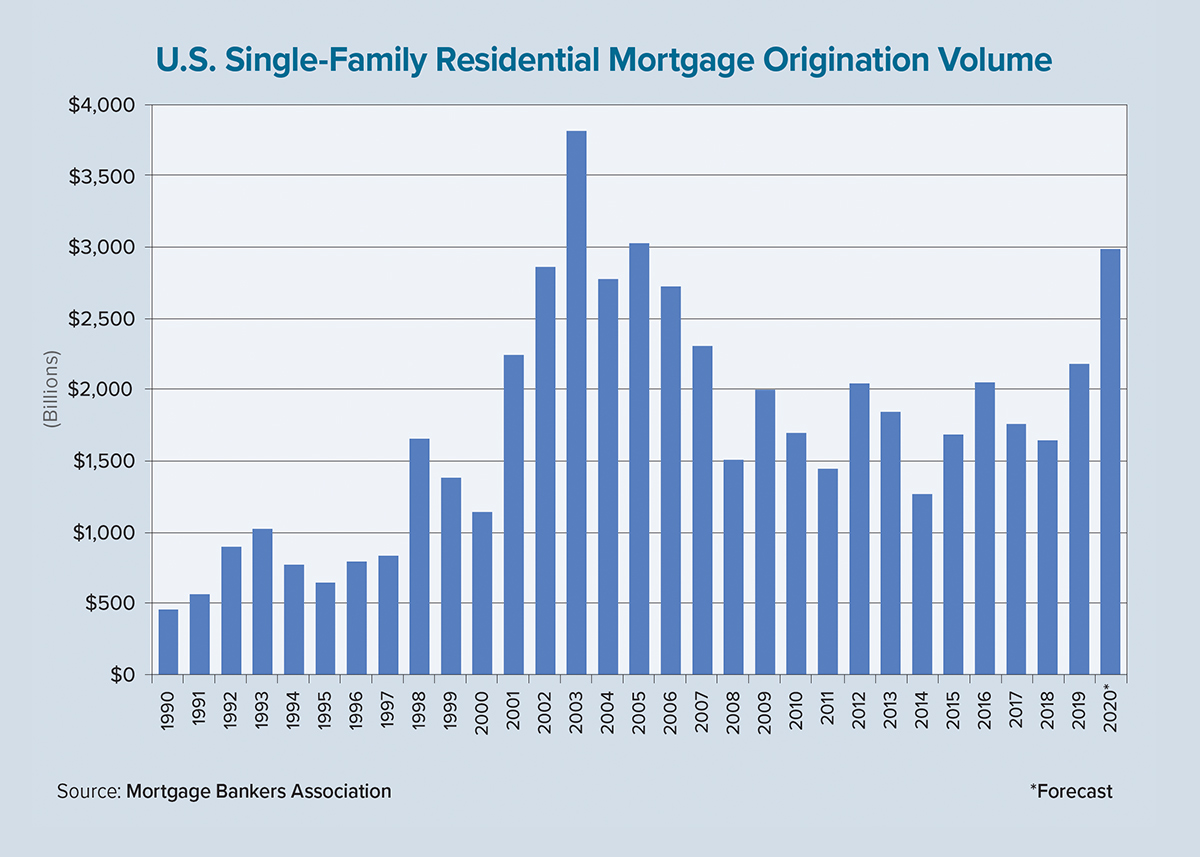The ongoing COVID-19 pandemic continues to negatively impact both the health and the finances of households and businesses across America. The efforts to contain the spread of the virus have turned our lives upside down, including how we live, work, play and interact with others.
How bizarre has this year been? Start by looking at data reported this past summer. A 32.9% annualized contraction in U.S. gross domestic product during the second quarter was accompanied by the expectation of a double-digit rebound in third-quarter 2020. There was an acceleration of the year-long mortgage refinance wave as interest rates dropped below the 3% barrier. Unemployment rates were well into the double digits and new weekly jobless claims consistently surpassed 1 million. Meanwhile, residential purchase mortgage applications were up year over year for three straight months even as the recession continued to harm certain economic sectors such as travel, arts and entertainment, retail and hospitality.
The nature of this crisis is likely boosting demand — there is no place like home. Additionally, millions of homeowners are taking advantage of historically low rates to refinance, which in turn is allowing them to increase their savings, pay down other debt or increase new spending. The Federal Reserve’s commitment to keeping short-term rates at zero, as well as its significant purchases of mortgage-backed securities, are helping to keep rates low and thus ensuring the mortgage market functions smoothly.
Early this past August, the 30-year fixed-rate mortgage fell to a new record low of 3.03%, according to the weekly application survey from the Mortgage Bankers Association (MBA). For the year, the MBA’s forecast calls for rates to average 3.1% percent, meaning that millions of homeowners stand to benefit. Refinance activity for the year is expected to jump by a remarkable 83% to $1.65 trillion — the strongest year for refis since 2003 ($2.53 trillion).
Times have certainly changed for the home-purchase market since the onset of the pandemic this past March. Despite unfathomable job losses, pent-up homebuyer demand from this past spring has shifted the market into a higher gear. The boost has primarily come from households that have been working remotely during the pandemic and yearn for more space.
Although the virus continues to lurk as a formidable threat to public health, the economy and housing markets, home sales are poised to break out in the final months of this year. They did so in July 2020, jumping 25% compared to the prior month. Housing supply is slowly rising as construction starts were up 23% year over year in July, but the lack of existing inventory is limiting the choices and weakening the purchasing power of prospective buyers. The MBA, however, still expects purchase mortgage originations to climb 5% from 2019 to $1.34 trillion. That is a figure not seen since the $1.4 trillion volume of 2006.
Even more eye-opening than this year’s impressive purchase and refinance origination forecasts is the fact that these numbers could be higher. The abrupt weakening of the economy and job market, along with millions of homeowners going into forbearance plans, has pulled down MBA’s Mortgage Credit Availability Index to levels not seen since 2014. Lenders continue to navigate the increased risk and uncertainty in the economy, along with the costs of helping millions of families with forbearance. Overall, $2.99 trillion in originations — the most since 2005 ($3.02 trillion) — is expected in 2020.
Unfortunately, not everything is rosy. Homeowners and renters affected by the pandemic through furloughs, unemployment or underemployment are feeling the pain. The jump of nearly four percentage points in the mortgage delinquency rate during second-quarter 2020 was the largest quarterly rise since the launch of MBA’s National Delinquency Survey in 1979. In August, nearly 3.6 million homeowners (or 7.2% of all U.S. mortgages) were in forbearance plans.
Ultimately, the economic crisis will be with us until the public health crisis is solved. A sense of normalcy and a more robust economic recovery greatly depend on slowing the spread of the virus, hopefully through the development of a vaccine and effective treatments. ●
Author
-

Mike Fratantoni is chief economist and senior vice president of research and industry technology at the Mortgage Bankers Association (MBA). He is responsible for overseeing MBA’s industry surveys, benchmarking studies, economic and mortgage origination forecasts, industry-technology efforts, and policy-development research for the single-family and commercial/multifamily markets. Prior to joining MBA, Fratantoni worked in risk management and senior economist roles at Washington Mutual and Fannie Mae.




